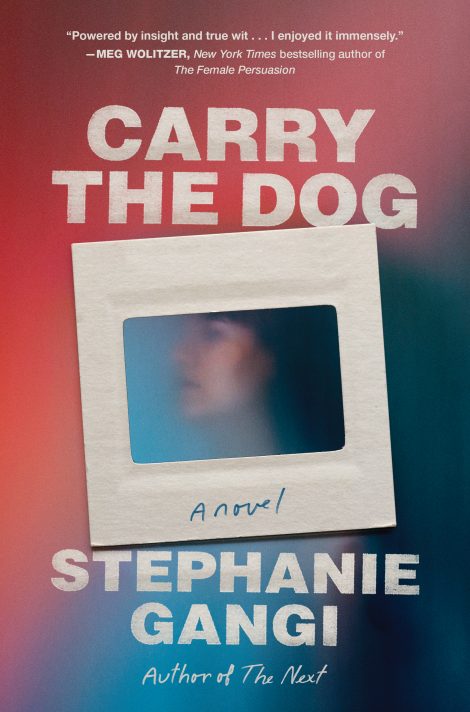
CARRY THE DOG
Bea Seger has spent a lifetime running from her childhood. The daughter of a famous photographer, she and her brothers were the subjects of an explosive series of images in the 1960s known as the Marx Nudes. Disturbing and provocative, the photographs shadowed the family long past the public outcry and media attention. Now, decades later, both the Museum of Modern Art and Hollywood have come calling, eager to cash in on Bea’s mother’s notoriety. Twice divorced from but still entangled with aging rock star Gary Going, Bea lives in Manhattan with her borrowed dog, Dory, and sort-of sister, Echo.
Bea Seger has spent a lifetime running from her childhood. The daughter of a famous photographer, she and her brothers were the subjects of an explosive series of images in the 1960s known as the Marx Nudes. Disturbing and provocative, the photographs shadowed the family long past the public outcry and media attention. Now, decades later, both the Museum of Modern Art and Hollywood have come calling, eager to cash in on Bea’s mother’s notoriety. Twice divorced from but still entangled with aging rock star Gary Going, Bea lives in Manhattan with her borrowed dog, Dory, and sort-of sister, Echo. After years of avoiding her past, Bea must make a choice: let the world in—and be compensated for the trauma of her childhood—or leave it all locked away in a storage unit forever.
Carry the Dog sweeps readers into Bea’s world as the little girl in the photographs and the woman in the mirror meet at the blurry intersection of memory and truth, vulnerability and resilience.
- Algonquin
- Hardcover
- November 2021
- 288 Pages
- 9781643751276
About Stephanie Gangi
 Stephanie Gangi is a poet, essayist, and novelist. Her award-winning poem, “Four,” was published in the Hippocratic Prize Anthology. Her acclaimed debut novel, The Next, was a finalist in the Writers@Work Annual Writing Competition. Her essays have been published in Literary Hub, Catapult, The Woolfer, Bust, TueNight, and NextTribe. Gangi wrote the first draft of Carry the Dog at the Leopardi Writing Conference in Recanati, Italy, after winning the Jeannine Cooney Scholarship for Excellence in Fiction . She lives in New York City.
Stephanie Gangi is a poet, essayist, and novelist. Her award-winning poem, “Four,” was published in the Hippocratic Prize Anthology. Her acclaimed debut novel, The Next, was a finalist in the Writers@Work Annual Writing Competition. Her essays have been published in Literary Hub, Catapult, The Woolfer, Bust, TueNight, and NextTribe. Gangi wrote the first draft of Carry the Dog at the Leopardi Writing Conference in Recanati, Italy, after winning the Jeannine Cooney Scholarship for Excellence in Fiction . She lives in New York City.
Praise
“I can’t remember the last time I was as completely bewitched by a fictional character as I was by Bea Seger in Stephanie Gangi’s Carry The Dog. What a treat to view life through the eyes of this funny, smart, gutsy woman, who has suffered its outrageous slings and arrows, and just keeps coming back for more.”—Richard Russo, author of Empire Falls and Chances Are . . .
“Stephanie Gangi’s Carry the Dog is powered by insight and true wit as it explores families and their aftershocks, as well as art, regret, and the state of being an older, desiring female in a world that too often looks away. I enjoyed it immensely.”—Meg Wolitzer, New York Times bestselling author of The Female Persuasion
“Prickly but vulnerable, Bea is an irresistible character, and Gangi’s novel is less a chronicle of growing up in the shadow of an artist parent as it is a late-in-life coming-of-age story. Fans of Gail Honeyman’s Eleanor Oliphant Is Completely Fine (2017) will find as much to love in this novel as those of Myla Goldberg’s Feast Your Eyes (2019) and Dawnie Walton’s The Final Revival of Opal Nev (2021).—Booklist, starred review
“Memorable . . . Most endearing is the character of Bea, who deals with the physical, psychological, economic, and romantic challenges of aging with humor and attitude.”—Publishers Weekly
“A smart, sophisticated, lively read.”—Kirkus Reviews
Discussion Questions
1. The first line of Carry the Dog is “I’m in the dark, I can’t see.” What do these words reveal about Bea? How does this reverberate through the rest of the book?
2. The philosopher Soren Kierkegaard said, “Life must be understood backwards but lived forwards.” Bea is fifty-nine years old and has done the latter without dealing with the former. Why has it taken her so long to look at the past? Why now?
3. In what ways does Bea resist the cliché of “older woman”?
4. As Bea is confronted with new truths about her family, she realizes that her own faulty memory, wrong assumptions, and impulse to compartmentalize have all contributed to her being “stuck.” How do these traits of Bea’s play out in the novel in terms of her relationships? Her career? In addition to the ways they’ve held her back, have they also helped her become more resilient?
5. Bea is a baby boomer, and the novel’s backdrops—photography and rock and roll—are, for her, twin pillars of her generation’s culture. What else in the novel do you associate with boomers? How does Bea’s boomer identity shape the way she looks at Echo’s world?
6. The past is alive for Bea in many ways, in particular through storage unit #201 at StoreSpace. Have you ever found yourself unexpectedly confronted with physical reminders of the past? How did you react?
7. Carry the Dog is a book full of brand names and fashion and objects. How do Bea’s belongings help ground her? Which of your “everyday things” help ground you?
8. The novel’s epigraph is the brief Mary Oliver poem “The Uses of Sorrow”:
Someone I loved once gave me
a box full of darkness.
It took me years to understand
that this, too, was a gift.
What “gifts” do trauma and loss deliver to Bea in Carry the Dog?
9. “. . . Miri’s photographs showed that childhood is dark, innocence is a myth, motherhood is a trap, and art—Art—will set you free.” This is Dr. Yeun’s perception of Miri’s work. She believes that although making art took its toll on the Marx family, it was a higher calling than motherhood; Miri was obligated to honor it because of her unique voice and talent. What do you think?
10. The reader learns that Miri’s own secret trauma fueled her art. Does the context make a difference to you as a reader in your perception of Miri?
11. Names are significant in this book. Bea herself has many: hyphenated and unhyphenated names, nicknames, pet names. Other characters, too, have names that are evocative and meaningful. What meanings can you identify?
12. Four key relationships define Bea’s reality: Gary, Dory, Echo, and Henry. With each, Bea gives and receives great love, but she mistrusts the love that’s returned. She is always on the lookout for disloyalty, betrayal, and abandonment. Why? What does she learn?
13. Malcolm Bix offers the lure of fame and fortune, while Dr. Violet Yeun offers an artistic legitimization of Miri’s work. Bea is conflicted. What do you think of her ultimate decision?
14. What is the last sentence of the novel? Why do you think the author chose it to end Bea’s journey?
